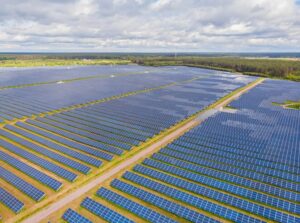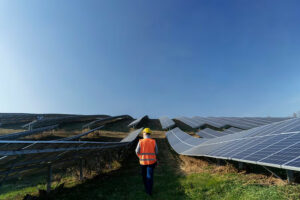
Summary Description
247Solar Plant™ has its origins at MIT, and the co-founder of the original company in 2001 that developed the technology was an MIT professor, Dr. David Gordon Wilson. The other co-founder, Bruce Norman Anderson, is also the founder and CEO of 247Solar Inc. He did his master’s Thesis at MIT on solar energy and is a co-inventor of the various 247Solar technologies and products. The US Department of Energy contributed to technology development with a $6 million investment. More than $25 million has been invested in developing this technology, mainly from individuals and their family trusts.
In addition to MIT and US support, the 247Solar Plant benefits from the following key development partners and suppliers.
The 247Solar Plant is the innovative integration of 4 advanced technologies:
- 247Solar Heat2Power™ air turbine
- 247Solar Receiver™
- An innovative thermal energy storage system (TES) from a third-party supplier
- An innovative heliostat from a third-party supplier
- 247Solar Heat2Power™ Air Turbine
A critical scientific advance that makes the 247Solar Plant™ a considerable breakthrough is the development of a super-high temperature 247Solar Heat Exchanger™ (247HX). We inserted this unique 247HX into the world’s best-selling and most reliable small air turbine, the C200, by Capstone Green Energy Corporation [NASDAQ: CGRN] in the USA. 1000s of conventional C200 turbines have been deployed worldwide, and they are the best-selling and most reliable turbines in their class. The 247HX’s inlet flow is from the atmospheric-pressure hot air (at 970oC) from the 247Solar Receiver (see below). The 247HX heats the turbine’s compressed hot air after it flows through its recuperator to become pre-heated. After it flows through the 247HX, the compressed air is fully heated to the required turbine inlet temperature (TIT), eliminating the need for a combustor. An external in-line combustor inside the duct that delivers the hot air from the Receiver provides optional fuel combustion to guarantee 24/7 dispatchable power. A small blower at the turbine’s exhaust pulls air through the 247 system. The result is the 247Solar Heat2Power™ turbine, the first commercial turbine in the world that produces electricity from ambient pressure hot air. The backup fuel can be fossil fuels, biofuels, or hydrogen.
The 247Solar Plant includes two such turbines for a total power output under ISO conditions of 400 KWe at % electrical efficiency of 32%. This results in an extra level of reliability from a commercial turbine that today is the best-selling and most reliable of its size and class. It uses air bearings, which last “forever.” The conventional C200 turbine requires just 4-8 hours of routine maintenance per year, has an MTBF between 40,000 and 80,000 hours, and requires no on-site operator. But to modify the turbine, 247Solar removed the combustor, which reduces time requirements for routine maintenance and lengthens MTBF.
The turbine also produces 600 kWth of industrial-grade heat at a temperature of 250℃. This “combined Heat and Power” (CHP) system broadly applies to numerous industrial facilities. Examples include routine hot water, drying minerals, purification, absorption chilling, etc.
Note that this turbine does not use steam but instead uses hot air. This is crucial for 24/7 clean power technologies, particularly for water-starved regions such as Namibia.
Note also that this turbine does not require the hot air that drives it to be solar-heated hot air. Other sources of hot air can also be used, including the combustion exhausts from numerous industrial facilities. This means the Heat2Power turbines can use factory hot air, otherwise wasted in the atmosphere, to create power.
- 247Solar Receiver™
The second major advanced technology is the 247Solar Receiver™. It is a much larger, ambient pressure and simplified version of a proven solar receiver by DLR of Germany. It has no moving parts and receives sunlight reflected from the heliostat field. Under ISO conditions, it produces ~2.2 MWth of hot air at 970oC. This is the world’s highest operating temperature for a commercial receiver. During the day, some heat powers the two Heat2Power turbines, and some is diverted to the 247Solar Thermal Storage System™.
Note that the 247Solar Plant can be modified to have some or all of the Receiver’s hot air directed to an industrial facility’s high-temperature requirement. If the condition is for hot air of less than 970oC, ambient air can be mixed to bring the temperature down to the needed.
- An innovative thermal energy storage system (TES) from a third-party supplier
The third major advanced technology is a third party’s innovative thermal energy storage system (TES). The TES is a cargo container-sized system that is shipped to the site empty and then filled with a heat storage medium. It’s super-insulated, made in factories, and sent to the place open, filled with sand, small pieces of ceramic, or slag from the steel refining process. The TES typically operates between 600C and 1200C. During the day, the portion of the hot air from the solar Receiver not used by the turbines is diverted to the TES. It enters from the top at 970C and is discharged at the bottom at about 650C. The air then returns to the Receiver for re-heating. At night, the exhaust air from the turbine enters at the bottom, comes out the top, and flows to the turbines to produce power. There are no moving parts, O&M is expected to be minimal, and life is measured in decades.
The size of the storage system is tailored to the application and ranges from 4 to 20 hours. Heat loss depends on insulation levels and is 1-2% daily. Round trip efficiency is >95%. 247Solar continuously surveys the market for new, better, and lower-cost TES suppliers.
- An innovative heliostat from a third-party supplier
The fourth major advanced technology is the heliostat, a mirror on a pedestal that tracks the sun to reflect the light into the solar Receiver. The heliostat used by 247Solar at its first commercial-scale (400 kW) demonstration of the 247Solar Plant in the USA has several unique design features. Most heliostats are stowed at night with their mirrors facing the sky. This can cause the mirrors to be soiled in some locations by a sticky mix of moisture (dew), dust, and air pollution. They also are subject to adverse weather, including sandstorms and hail. In much of the Middle East, significant expense is usually required to clean the hard-to-remove dirt from the mirrors deposited at night. This heliostat’s first unique design feature avoids these severe and expensive problems by stowing the mirrors facing down.
The heliostat’s additional unique design features significantly reduce installation costs and improve seating flexibility. Features include:
- They are mounted on piles driven into the ground, which avoids the cost of concrete foundations and makes them suitable for deployment on uneven ground.
- The tracking of each heliostat is controlled wirelessly.
- Finally, each heliostat is rotated using its integrated solar cell and battery.
- Among other things, these features avoid the damage to the site that comes with pouring concrete foundations and digging trenches for wiring.
The typical size of a field of heliostats for 247Solar Plants is 4500 sq m, and the required land area of each Plant is about two hectares or 20,000 sq m. The needed space can be more significant for DNI under 2200 kWh/year. These sizes are finalized when an actual system solution is being engineered. 247Solar continuously surveys the market for new, better, lower-cost heliostats.

The entire 247Solar Plant
These above four advanced technologies have been integrated into the 247Solar Plant™ that can operate 24/7, every hour of the year. The 247Solar Plant and its operation are shown below.
HeatStorE™ Long-Duration “All-Night” Battery
247Solar’s Heat2Power turbine is combined with a TES to form the 247Solar HeatStorE™ “all-night” battery. Such a battery performs identically to electric batteries connected to main grids, i.e., they absorb power from the grid when there is an excess, such as from PV or wind, but convert it to stored heat up to 1000C via electric resistance coils. The turbine converts the heat back to electricity when the demand on the grid exceeds its capacity, e.g., during peak periods.
The battery can operate at full power even when fully discharged for 24/7 dispatch. When the TES is depleted, the turbine can burn almost any fuel, including hydrogen, for full power 24/7 operation under any conditions.
Zero-Carbon 247Solar Microgrids™
Optimized integration of a combination of 247Solar Plants, HeatStorE batteries, PV, wind turbines, batteries, and central controller forms a zero-carbon 247Solar Microgrid. This approach helps microgrids minimize power costs while providing both baseload and variable and surge loads throughout the day and year. The system offers 24/7 baseload power and variable output depending on the state of operation of the PV field. HeatStorE batteries use their low-cost thermal storage system to absorb excess energy from PV and wind during the day and return it to the microgrid or primary grid as needed. Their turbines can join the turbines associated with 247Solar Plants to supply the power demand of any microgrid. Lower cost but highly variable PV and wind supply some loads to reduce overall LCOE. Their excess output is stored as heat for later use in the HeatStorE batteries. Electrochemical short-duration batteries fill in the intermittent and fluctuating output from PV and wind.
PV Fields
247Solar adds PV fields to many of its systems provided by third-party suppliers. Typically, it issues an RFQ or enters into agreements with a specific company to collaborate in particular countries or regions. The PV field has four functions: 1) provide power to the project when the sun shines; 2) charge the TES; 3) supply power to the CSP system to operate its blowers; and 4) assist in meeting daytime surge loads. A small set of electrochemical batteries, such as Li-Ion, is typically included to enable the field to supply constant power output during intermittent operation due to passing clouds of unusual peak loads.